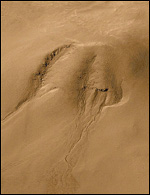The theory may explain the existence of water channels in the star despite its stagnation; If confirmed, the chance of life on the planet increases

Snow that fell on the planet Mars millions of years ago caused the formation of the water reservoirs flowing on the planet - so claims a new study published in the USA. The new theory is based mainly on photographs by the American Space Agency (NASA), in which water channels are visible. These findings may imply the existence of primitive life forms on the surface of Mars.
Studies published in recent years have pointed to sources of water on the surface of the Red Planet. A new paper published just last week revealed that underground water reservoirs exist at both poles of Mars. Until now, the researchers believed that the channels discovered in satellite images of the star flowed water coming from underground sources. However, this theory is highly questionable, partly because the average temperature on the surface of Mars is minus 63 degrees Celsius. Also, in the NASA photographs it can be seen that the canals were actually formed in high places on the surface of the planet, and not in low places, where water usually begins to accumulate. The new theory, published in the scientific journal "Nature" tries to link the water channels with the fact that flowing water is only possible at a temperature higher than zero degrees.
Dr. Philip Christensen from the University of Tempe in Arizona speculates that the water channels on Mars are covered with snow. According to his findings, snow that fell on Mars millions of years ago - when warmer weather prevailed on the planet - accumulated at both poles. When the sun's rays heat the surface of the star, an effect similar to the greenhouse effect is created inside the snow-covered channels. The upper layer of snow, which is also composed of dust, protects the lower layer and warms it. As a result, the temperature rises in the lower layer, and water flows under the upper snow layer.
According to this theory, the snow layers formed in the coldest regions of Mars. According to Dr. Kristinsen, his research can explain why the canals begin precisely in the high areas above the poles of the star. "When I examined the satellite photos, I said to myself, 'Ah,' the snow initially piled up precisely in the higher areas, right at the edge of the cliff," explains Kristensen, "and then suddenly I understood everything, I saw that immediately afterwards the snow piled up in lower places as well, and eventually a flow develops The water is in the lower layer."
"The whole point of this story is life. As soon as there is water there is life", emphasizes the astrophysicist Prof. Avishai Dekel from the Hebrew University of Jerusalem, "it is not about people swimming there under the snow cover, but it is certainly possible to find small algae in the canals, and maybe even primitive animals".
The findings presented in the study will be tested in the upcoming NASA flights to Mars. The space agency intends to launch a space vehicle to the Red Planet, which will investigate the sources of water already at the end of the year. Before the Columbia space shuttle disaster, the Bush administration announced that it would send a manned vehicle to Mars by the end of the decade.
Valleys bigger than those on Earth
Dr. Noah Brosh
In many places on the surface of Mars, which have been photographed, valleys similar to river channels in Israel are visible. Example Part of "Mariner Valley", named after the first spacecraft that photographed the surface of Mars about 40 years ago. The route of the landscape extends for about 4,000 km in the equatorial region of Mars.
In the wide place, the distance between the opposite walls is about 600 km and the height of the walls from the bottom of the valley reaches 10 km.
The valleys coming out of the main valley are also large; Their width can reach about 100 km. The valleys of Mars are therefore much larger than those of the Earth. They were formed when the upper layer of the surface of Mars collapsed and secondary valleys were formed, possibly under the influence of flowing water.
